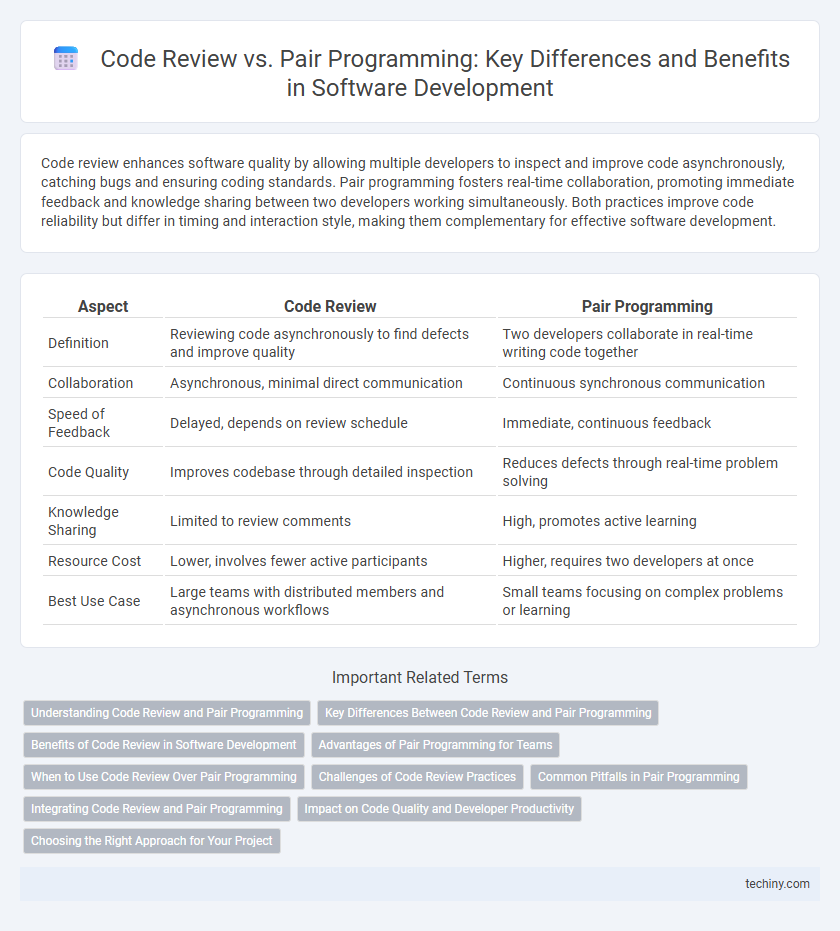Code review enhances software quality by allowing multiple developers to inspect and improve code asynchronously, catching bugs and ensuring coding standards. Pair programming fosters real-time collaboration, promoting immediate feedback and knowledge sharing between two developers working simultaneously. Both practices improve code reliability but differ in timing and interaction style, making them complementary for effective software development.
Table of Comparison
| Aspect | Code Review | Pair Programming |
|---|---|---|
| Definition | Reviewing code asynchronously to find defects and improve quality | Two developers collaborate in real-time writing code together |
| Collaboration | Asynchronous, minimal direct communication | Continuous synchronous communication |
| Speed of Feedback | Delayed, depends on review schedule | Immediate, continuous feedback |
| Code Quality | Improves codebase through detailed inspection | Reduces defects through real-time problem solving |
| Knowledge Sharing | Limited to review comments | High, promotes active learning |
| Resource Cost | Lower, involves fewer active participants | Higher, requires two developers at once |
| Best Use Case | Large teams with distributed members and asynchronous workflows | Small teams focusing on complex problems or learning |
Understanding Code Review and Pair Programming
Code review is a systematic examination of source code by developers other than the author to identify defects, improve code quality, and ensure adherence to coding standards. Pair programming involves two developers working collaboratively at one workstation, continuously reviewing each other's code in real-time to foster knowledge sharing and immediate feedback. Both practices enhance software reliability and maintainability but differ in timing and interaction dynamics.
Key Differences Between Code Review and Pair Programming
Code review involves a systematic examination of code by one or more developers after it has been written, enhancing code quality and catching potential issues before integration. Pair programming requires two developers to collaboratively write code in real-time, fostering immediate feedback and knowledge sharing. The primary difference lies in timing and collaboration: code review is a post-development evaluation, whereas pair programming is an ongoing, synchronous coding activity.
Benefits of Code Review in Software Development
Code review enhances software quality by systematically identifying bugs, improving code readability, and fostering adherence to coding standards. It promotes collective code ownership, enabling team members to share knowledge and reduce knowledge silos. Ensuring early detection of defects lowers the cost of fixing issues and accelerates overall development cycles.
Advantages of Pair Programming for Teams
Pair programming enhances code quality by enabling real-time collaboration and immediate feedback, reducing bugs and improving design consistency. It fosters knowledge sharing and team bonding, accelerating skill development and aligning coding standards across team members. Continuous communication during pair programming leads to quicker problem-solving and a more cohesive, productive development environment.
When to Use Code Review Over Pair Programming
Code review is ideal for ensuring code quality in asynchronous workflows, allowing developers to thoroughly inspect changes without interrupting their tasks. It is particularly effective for large teams or remote environments where simultaneous collaboration is challenging. Use code review over pair programming when diverse expertise is needed to catch complex issues and maintain consistent standards across a codebase.
Challenges of Code Review Practices
Code review challenges include inconsistent feedback quality, delayed integration due to review bottlenecks, and difficulty in maintaining reviewer engagement over time. These issues often lead to overlooked defects and reduced codebase quality. Effective code review practices require clear guidelines, adequate time allocation, and reviewer expertise to ensure thorough and constructive evaluations.
Common Pitfalls in Pair Programming
Pair programming often faces common pitfalls such as mismatched skill levels, which can lead to frustration or unequal contribution between partners. Communication breakdowns may result in overlooked errors or inefficient problem-solving during the coding process. Fatigue and reduced focus from prolonged sessions can also decrease productivity and negatively impact code quality.
Integrating Code Review and Pair Programming
Integrating code review and pair programming enhances software quality by combining real-time collaboration with thorough post-development analysis. Pair programming facilitates immediate feedback and knowledge sharing between developers, while code review provides a structured audit of the codebase, ensuring compliance with coding standards and detection of defects. This combined approach accelerates defect resolution, improves code maintainability, and fosters continuous learning within development teams.
Impact on Code Quality and Developer Productivity
Code review improves code quality by enabling multiple developers to identify bugs, enforce coding standards, and share best practices, while maintaining individual workflow efficiency. Pair programming enhances real-time collaboration, leading to immediate error correction and knowledge transfer, which significantly boosts code quality but may reduce short-term developer productivity due to simultaneous work on the same task. Balancing these approaches can optimize overall software quality and team performance by combining thorough post-development inspection with proactive, continuous code validation.
Choosing the Right Approach for Your Project
Code review enhances code quality by allowing multiple developers to analyze and approve changes, making it ideal for large, complex projects with distributed teams. Pair programming fosters real-time collaboration and knowledge sharing, best suited for projects requiring immediate feedback and continuous integration. Selecting the right approach depends on project size, team structure, and development speed requirements to maximize productivity and code maintainability.
Code Review vs Pair Programming Infographic

 techiny.com
techiny.com